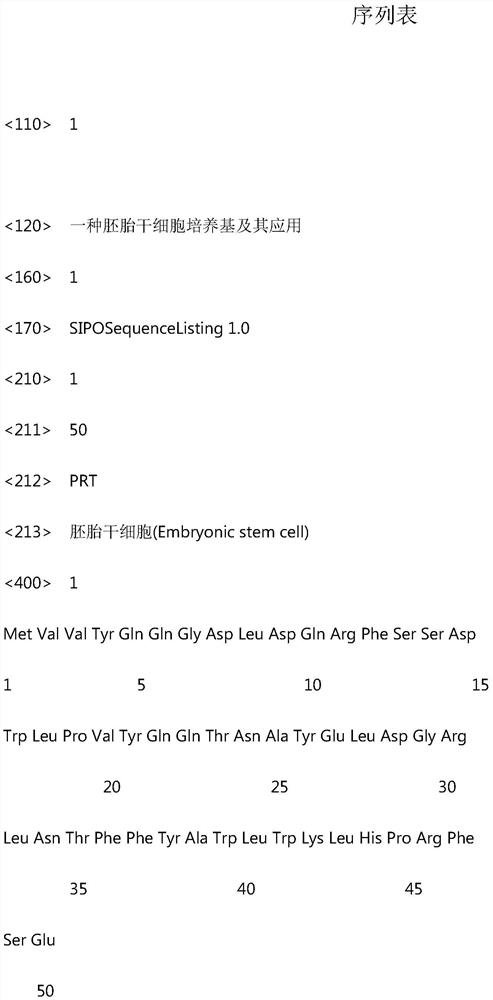A kind of embryonic stem cell culture medium and its application
A technology of embryonic stem cells and culture medium, applied in the field of stem cells, can solve the problems of slow growth of embryonic stem cells, affect cell expansion and application, and be prone to aging, etc., achieve high safety, broad application prospects, and ensure the effect of differentiation ability
- Summary
- Abstract
- Description
- Claims
- Application Information
AI Technical Summary
Problems solved by technology
Method used
Image
Examples
Embodiment 1
[0017] Embodiment 1, the cultivation of human embryonic stem cells (H1 cell line)
[0018] In order to verify the effect of the differentiation-inhibiting short peptide (as shown in SEQ ID NO.1) of the invention of the present application, the embodiment sets up an experimental group and a control group in particular, and the experimental group and the control group use the same method for culturing. The only difference between the two is: The culture medium used in the control group does not contain the short differentiation-inhibiting peptide.
[0019] Specifically, the medium components used in the experimental group are: N2 20mL, B27 20mL, glutamine 0.2g, β-mercaptoethanol 5μl, taurine: 0.2g, basic fibroblast growth factor 100mg, calf 0.5 g of serum albumin; 0.3 g of short differentiation inhibitory peptide (as shown in SEQ ID NO.1); dilute to 1000 mL with DMEM / F12.
[0020] The medium components used in the control group are: N2 20mL, B27 20mL, glutamine 0.2g, β-mercapto...
Embodiment 2
[0026] Example 2. Detecting the maintenance of the undifferentiated state of human embryonic stem cells
[0027] Oct4 and Tra-1-81 are commonly used indicators for detecting whether embryonic stem cells are in an undifferentiated state; by detecting the expression of the cells, it can be shown whether human embryonic stem cells are in an undifferentiated state. In this example, the method of cell immunofluorescence staining (Elisa double-antibody sandwich method) was used to further detect the expression of the genes Oct4 and Tra-1-81 in the 10th generation H1 cells, wherein rabbit anti-Oct4 and mouse anti-Tra-1 -81 was purchased from American Chemicon Company.
[0028]The test results showed that the expression of Oct4 and Tra-1-81 could be detected in the experimental group at the 6th, 8th, and 10th generations, and the detection intensity did not change; while the control group was at the 6th and 8th generations At the same time, the expression of Oct4 and Tra-1-81 could a...
Embodiment 3
[0033] Example 3. Totipotency Detection of Human Embryonic Stem Cells
[0034] In order to further evaluate the properties of the passaged embryonic stem cells of the present invention, the totipotency of the cultured human embryonic stem cells is now detected, and the differentiation ability of stem cells into keratinocytes is detected with reference to the method of patent CN104651298B. When cultured to the 40th day, the high expression of keratinocyte markers p63 protein, keratin 14 and 15 was detected in the passaged stem cells of the experimental group, and the cell morphology was close to that of human keratinocytes; while the expression of the above proteins in the control group was significantly lower than that of the experimental group. Group. As detected by flow cytometry, the expression rate of keratin 14 in the experimental group was as high as 70.31%, while that in the control group was only 22.62%.
[0035]
PUM
 Login to View More
Login to View More Abstract
Description
Claims
Application Information
 Login to View More
Login to View More - R&D
- Intellectual Property
- Life Sciences
- Materials
- Tech Scout
- Unparalleled Data Quality
- Higher Quality Content
- 60% Fewer Hallucinations
Browse by: Latest US Patents, China's latest patents, Technical Efficacy Thesaurus, Application Domain, Technology Topic, Popular Technical Reports.
© 2025 PatSnap. All rights reserved.Legal|Privacy policy|Modern Slavery Act Transparency Statement|Sitemap|About US| Contact US: help@patsnap.com

